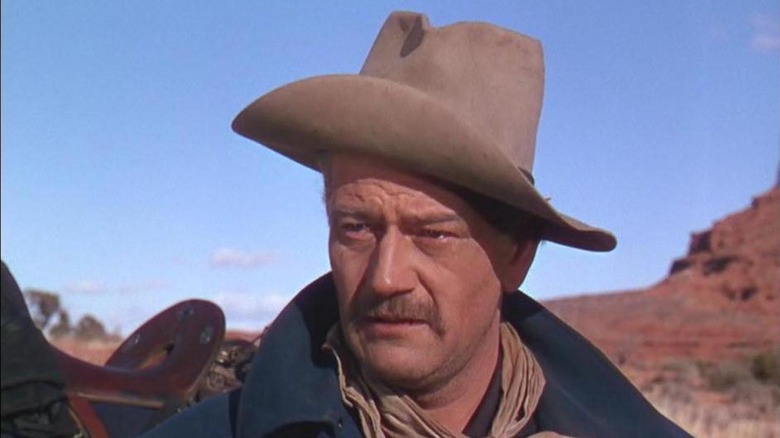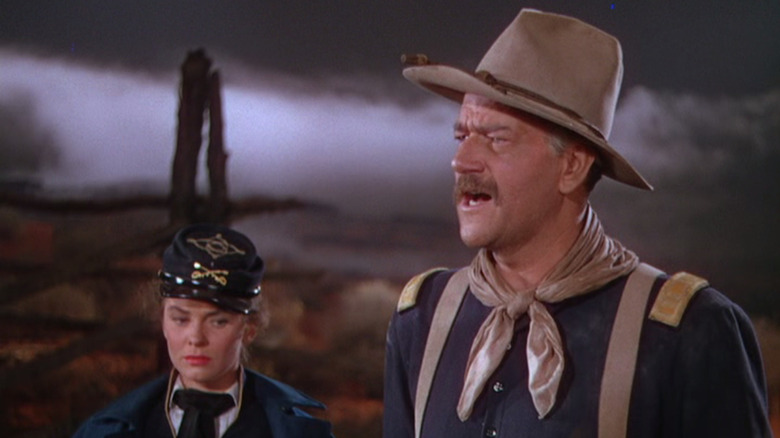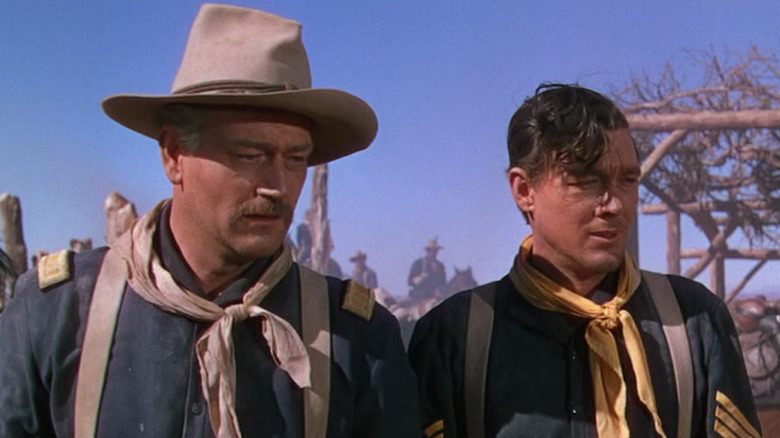Going Outside Of His 'Image' Gave John Wayne His Favorite Performance Of His Career
When someone makes the misguided assertion that John Wayne had no range or, worse, was actually a bad actor, you can be sure they've never seen "The Searchers," "Red River" or "True Grit." They most certainly haven't seen "She Wore a Red Ribbon," the conclusion to John Ford's "Cavalry Trilogy" which boasts what might very well be the finest performance of The Duke's career.
To be fair, Ford, Wayne's most trusted collaborator, wasn't entirely sold on Wayne's potential beyond his star power until he saw Howard Hawks' "Red River" in 1948. Upon seeing Hawks' Western, Ford reportedly exclaimed, "I didn't know the big son of a b**** could act." While it's worth noting that Ford had a penchant for razzing his frequent leading man, Wayne's portrayal of rancher Thomas Dunson is surprisingly shaded. Dunson is a hard, unyielding man at the outset, but an arduous cattle drive compounded by the conflict with his adopted son (Montgomery Clift) wears him down. Clift was one of the very first method actors, and he challenges The Duke every step of the way.
Now that the secret of Wayne's acting ability was out, Ford had just the role for him: Captain Nathan Brittles in "She Wore a Yellow Ribbon."
A bittersweet glimpse of The Duke in winter
Brittles was hardly tailor made for Wayne. He's a 65-year-old, near-retirement leader of a small Army troop stationed at Fort Starke in Texas. The Duke was 42 at the time of his casting, so Brittles is a preview of the world weary cowboys the star would play in the 1970s — the difference here being that this is actually a good movie. As with "Red River," "She Wore a Yellow Ribbon" offers a portrayal of indigenous peoples that is somewhat nuanced compared to your average Golden Age oater. Wayne's Brittles is friends with his Cheyenne counterpart Chief Pony That Walks (Chief John Big Tree), and wants dearly to strike a peace treaty with him before he cedes his post. This dynamic is not just unusual, but poignant, especially when viewed today in the context of Wayne's career.
But it's the age difference and Brittles' encroaching irrelevance that lends "She Wore a Yellow Ribbon" its poignancy. According to Scott Eyman's biography "John Wayne: The Life and Legend," The Duke understood this, and said as much:
"'She Wore a Yellow Ribbon' turned out to be, I think, the best acting job I've done. As a matter of fact, it's about the only picture I've been in where I could play a character that was a little apart from the image that has developed for me over the years on the screen. I played a 65 year old man when I was 35 [actually, 42].'"
An Oscar dream deferred
Though "She Wore a Yellow Ribbon" was favorably received by critics, it only received one Academy Award nomination (for Winton C. Hoch's vibrant color cinematography, which it won). Wayne did receive his first Oscar nod for Best Actor that year, but it was for his dies-with-his-combat-boots-on performance in Allan Dwan's sturdy, if unspectacular "Sands of Iwo Jima."
It's often the case that actors never win for their best work (e.g. Al Pacino, Denzel Washington and Leonard DiCaprio), but for Wayne to not even be nominated for "She Wore a Yellow Ribbon" (or "Red River") remains an egregious miscarriage of Oscar justice. While he was entertainingly hammy as the eye-patched Rooster Cogburn in "True Grit," perhaps the popular perspective of Wayne's performing talents would be different had he earned an Oscar for one of the performances that undeniably proved the son of a b**** could act.


